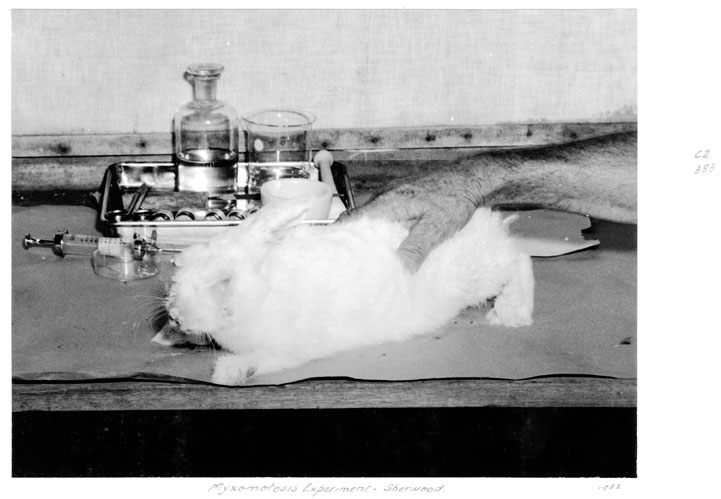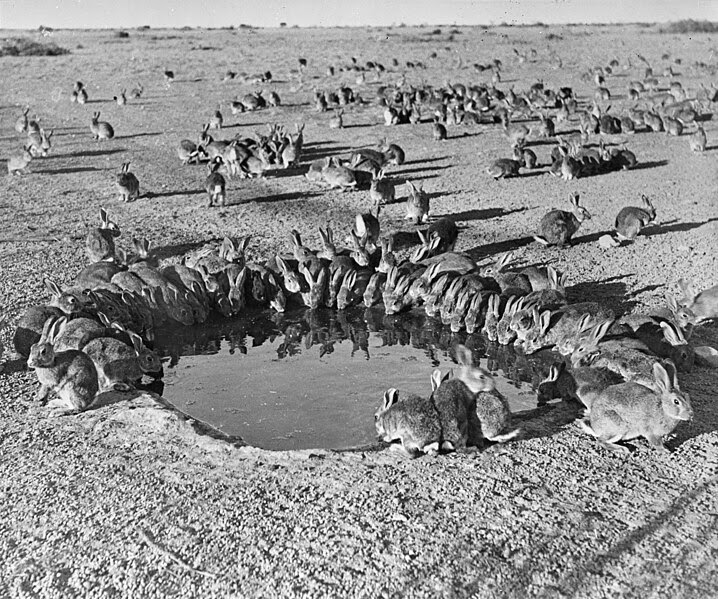Releasing the Myxoma Virus for Rabbits. Rabbits were introduced to Australia by
early European settlers, and by the 20th century has become a plague.
They ravaged the country, destroying pastures, crops and native species.
In the early 1930s Dame Jean Macnamara (and others) called for the
importation of the myxoma virus as a means of control. Lionel Bull,
Chief of the CSIR Division of Animal Health and Nutrition, released the
first infected rabbits on 16 November, 1937 on Wardang Island, South
Australia. By the 1950s the deadly virus had caused an epidemic and
killed off much of the wild rabbit population: photographer unknown, 1937 via CSIRO (Commonwealth Science and Industrial Research Organization)
Caught in the centre of a soundless field
While hot inexplicable hours go by
What trap is this? Where were its teeth concealed?
You seem to ask.
.....I make a sharp reply,
Then clean my stick. I’m glad I can’t explain
Just in what jaws you were to suppurate:
You may have thought things would come right again
If you could only keep quite still and wait.
Philip Larkin (1922-1985): Myxomatosis, 1954, from The Less Deceived, 1955
Myxomatosis is a highly infectious viral disease affecting rabbits, characterized by fever, swelling of the mucous membranes, and presence of myxomata (an acellular slime mould). It was first observed in Uruguay in the late 19th century, effectively developed for rabbit population control in the twentieth century in Australia, and soon spread to Europe. An epidemic of myxomatosis killed millions of rabbits in England in 1953. In that initial outbreak rabbits lacking immune resistance to the disease typically succumbed within forty-eight hours. One of the most visible symptoms noted in affected rabbits was a crippling lethargy.
Rabbits around a waterhole at the myxomatosis trial enclosure on Wardang Island: photographer unknown, 1938 (National Archives of
Australia

Experimental laboratory, Sherwood: photo by Lands Department, Survey Office, Cartographic Branch, Photographic Section, c. 1952 (Queensland State Archives)

Myxomatosis kit, Sherwood: photo by Lands Department, Survey Office, Cartographic Branch, Photographic Section, c. 1951 (Queensland State Archives)

Myxomatosis experiment, Sherwood: photo by Lands Department, Survey Office, Cartographic Branch, Photographic Section, c. 1952 (Queensland State Archives)

Myxomatosis experiment, Sherwood: photo by Lands Department, Survey Office, Cartographic Branch, Photographic Section, c. 1952 (Queensland State Archives)

Myxomatosis experiment, Sherwood: photo by Lands Department, Survey Office, Cartographic Branch, Photographic Section, c. 1952 (Queensland State Archives)

Myxomatosis experiment, Sherwood: photo by Lands Department, Survey Office, Cartographic Branch, Photographic Section, c. 1952 (Queensland State Archives)

Myxomatosis experiment, Sherwood: photo by Lands Department, Survey Office, Cartographic Branch, Photographic Section, c. 1952 (Queensland State Archives)
A baby rabbit
With eyes full of pus
This is the work
Of scientific us
-- Spike Milligan (1918-2002)

Myxomatose op Voorne. Een konijn door de ziekte aangetast: photo by Winfried Walta / Anefo, 10 October 1963 (Dutch National Archives, The Hague, Fotocollectie Algemeen Nederlands Persbureau [ANeFo], 1945-1989)

Myxomatosis experiment, Sherwood: photo by Lands Department, Survey Office, Cartographic Branch, Photographic Section, c. 1952 (Queensland State Archives)

Myxomatosis experiment, Sherwood: photo by Lands Department, Survey Office, Cartographic Branch, Photographic Section, c. 1952 (Queensland State Archives)

Myxomatosis experiment, Sherwood: photo by Lands Department, Survey Office, Cartographic Branch, Photographic Section, c. 1952 (Queensland State Archives)

Myxomatosis experiment, Sherwood: photo by Lands Department, Survey Office, Cartographic Branch, Photographic Section, c. 1952 (Queensland State Archives)
A baby rabbit
With eyes full of pus
This is the work
Of scientific us
-- Spike Milligan (1918-2002)

Myxomatose op Voorne. Een konijn door de ziekte aangetast: photo by Winfried Walta / Anefo, 10 October 1963 (Dutch National Archives, The Hague, Fotocollectie Algemeen Nederlands Persbureau [ANeFo], 1945-1989)
Scientists with personal protective equipment
(PPE) testing samples from animals collected in Zaire for the Ebola
virus: photo by Ethleen Lloyd / Centers for Disease Control, 1995
(Centers for Disease Control /U.S. Department of Health and Human
Services)
But would things come right again if you could only keep quite still and wait?

Waterloo, Sierra Leone: Women faints as another reacts while volunteers (unseen) take away the body of a woman who died of Ebola: photo by Florian Placheur/AFP/Getty Images via the Guardian, 7 October 2014






7 comments:
Myxomatosis, a short film by Steve Dales
Myxomatosis in the UK
Current scientific thought is that we can invent pests for other pests we don't like.
But sometimes we can't control the consequences.
Killer bees and fire ants have been spreading throughout America for some time.
Deliberately introduced and accidentally introduced. Both methods have the same result.
"Foreign" species of animals are causing problems around the world, due mostly to unintended transport.
Is this an argument against the increasing portability and mobility of our age?
i don't mean to make things smaller. certainly your juxtaposition of myxomatosis and ebola are in no way gratuitous. where we add our hand, we alter the natural course. but as i began this post i couldn't help but think of the moose in a documentary i recently watched (moose being no less, no more, than rabbits or man), infested with ticks which were bloated to the size of grapes. infested! the ticks used to fall off in the early spring to a bed of snow, many (most) merely freezing to death, but now because of milder winters when they fall off they fall to soil and their numbers increase exponentially, which means the terror, if we can call something the moose know nothing about terror (and we can and should), exponentially increases, too. one unconscionable moment in the documentary saw a natural resources official raising his gun to put down a moose who had obviously been afflicted to a dangerous degree (meaning he was obviously ill and not afraid of people well enough - although he should have been), but before the official could shoot, the moose dropped dead in front of them. the ticks had quite literally sucked all life from him.
while the tick looks small, it is deceiving. while we might at times appear humane, this is deceiving, as well.
i can't imagine how we got here. it seems so obvious, how we should be behaving. and yet...
each day it seems my grieving deepens and yet no amount of grief will change anything. we know what will bring change and we ignore it.
i tremble with that last line from larkin's poem.
Now the rabbits, then the rest of us. Maybe sooner than we imagine, as even so-called advanced nations prove themselves inept in dealing with the Ebola crisis. Humans beings, it seems, are maladaptive animals. What we did to “improve” things improved nothing, long term. Civilization turns out to be the apocalypse on the installment plan.
This timeline of extinctions is instructive. http://en.wikipedia.org/wiki/Timeline_of_extinctions
Many thanks, friends.
Several points here.
First, Erin, about the tick infestation of the moose: from what I understand, global warming is producing similar climate imbalances leading to pest infestations now threatening many species. The myxomatosis epidemic in the UK, after a lapse of about three decades, has now, over the past decade, returned, the virus mutating into a new, more insidious form -- kills more slowly (and thus more cruelly), but allows some individuals to survive, thus keeping the host supply more or less stable -- to combat the inevitable development of immune response in surviving rabbits; this is a pest-borne virus, and it's thought by some that the increase in mosquito populations due to global warming is a factor in facilitating its recurrence and subsequent renewed advance.
In Australia the "scientific" response to the mutation and evolution of myxoma has been the development of new Dr Frankenstein eradication methods. They are now, I believe, introducing haemorrhagic fever into the rabbit population.
Playing God with other species as toys and victims remains SOP in many sectors of the noble "scientific" "community".
"Our" "enlightened" "stewardship"... and all the rest of that intolerable whistling-in-the-dark corporate rhetoric, adapted to grant applications but in fact not applying in any actual way to what humans do do, in "reality".
Larkin's chilling last line might now apply to us all.
It seems only a matter of time now, until the humans manage to eradicate all life. The one certainty I can see in this is the prospect of greater and greater funding for a few clever interested human parties, so that our extinction, while necessarily creating deprivation and suffering for most of us, will be well-lined with benefits and prosperity for the technicians, administrators & c.
As to what to do about mobility, Curtis, it's obviously a bit late to leave the Wright Brothers or Henry Ford out of the historical timeline --- but of course had they not done what they did, someone else would have rushed in to spill the milk (carbons, that is).
And talking of timelines, I see from the one Hazen has provided that there may not be too much line left any more...
Were one to be seeking an emblem of the moment though, how about the most recently disappeared species on that list.
"The Scioto Madtom (Noturus trautmani) was a species of fish in the Ictaluridae family. It is listed as extinct by the International Union for Conservation of Nature, which notes that it has likely been entirely or functionally extinct since 1957 given the lack of records since that year. The Scioto Madtom grew to a length of 2 1/4 inches, and was found in sandy gravel riffles.
"This fish was endemic to Ohio in the United States. Only one population was ever known; it was located in Big Darby Creek, a tributary of the Scioto River. Eighteen specimens were collected, all at one riffle in this creek, an area called Trautman's Riffle. It has not been seen since 1957."
Here today, gone tomorrow, leaving nothing but the distant memory of that last ripple on the water, as the shades of evening come down.
Milligan's poem catches that scoutmasters' arrogance.
We speak of Science as we once spoke of Religion, forever lousy with myth. We'll never grasp how provisional and fragile human culture is until...
I think a dread of Science and its arrogant technicians, comparable to the healthy dread of the priest classes in so many now-defunct religions, is growing among those still possessed of a modicum of common sense. Belated perhaps... but then again, maybe just in time... not of course to put "mankind" back on some sort of salutary course toward that perennial pot of gold just over the evolutionary rainbow, but at least to reduce somewhat the power of the relentless spate of wizardly dis/misinformation spewed upon the world, never more than now, at the eleventh hour (not before the final snuffing-out of species, mind, but before the grant-application deadline...)
Post a Comment